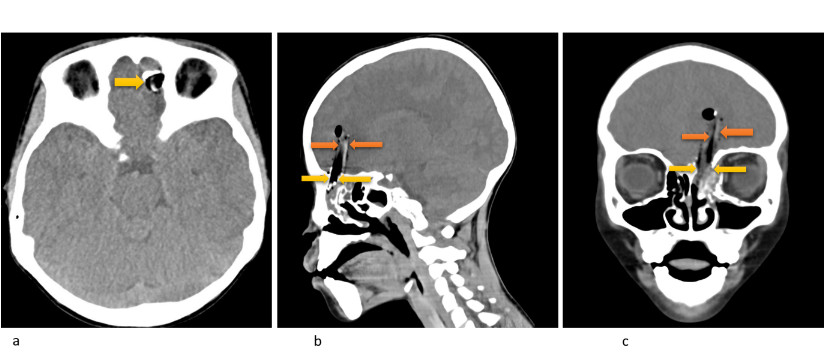Penetrating pediatric traumatic brain injury: Lessons from the surgical and medical management of penetrating cranial injury with wood in rural Kenya.
Abstract
Background: Penetrating cranial injury with wood is a rare injury that can be difficult to detect and has few treatment guidelines. Cases in rural Africa face limited access to the specialized care required to avoid adverse outcomes. Two pediatric cases emphasize the value of neurosurgical expertise in surgical and medical management of this complex and uncommon injury. Observations: In these cases, the nature and severity of the injuries were missed by family members (case 1) or clinicians (case 2) until several days after the injury. Wood is known to harbor numerous microorganisms due to its porosity, and is considered a contaminated foreign body. Thus, direct inoculation of the cranium by wood and debris led to the delayed formation of abscesses despite prophylactic antimicrobial therapy and extraction of wood fragments in both cases. Lessons: Penetrating traumatic brain injury from wood requires special attention due to the risk of delayed presentation and recurrent infection despite initial surgical washout and foreign body removal. Surgeons should anticipate the possibility of polymicrobial infection requiring multiple washouts before definitive infection control is achieved and continue monitoring the patient with clinical and imaging follow-up. There is value in exploring specific treatment algorithms with appropriate antimicrobial regimes.
References
Onyemaechi, N. O. (2020). Epidemiology and pattern of paediatric injuries in a developing country: an analysis of 170 injuries. Malawi medical journal, 32(2), 95-100.
2.Chikani, M. C., Aniaku, I., Mesi, M., Mezue, W. C., & Chikani, U. N. (2021). Characteristics and outcome of paediatric traumatic brain injuries: An analysis of 163 patients in Enugu. Nigerian Journal of Medicine, 34(4), 446-451.
Bellet, F. D., Rashid, S. M., Jusabani, M. A., Dekker, M. C. J., & Temu, R. J. (2019). The characteristics of cervical spinal cord trauma at a North Tanzanian Referral Hospital: a retrospective hospital-based study. The Pan African Medical Journal, 33.
Macha, A. P., Temu, R., Olotu, F., Seth, N. P., & Massawe, H. L. (2022). Epidemiology and associated injuries in paediatric diaphyseal femur fractures treated at a limited resource zonal referral hospital in northern Tanzania. BMC Musculoskeletal disorders, 23(1), 1-7.
Buitendag, J. J. P., Kong, V. Y., Bruce, J. L., Laing, G. L., Clarke, D. L., & Brysiewicz, P. (2017). The spectrum and outcome of paediatric traumatic brain injury in KwaZulu-Natal Province, South Africa has not changed over the last two decades. South African Medical Journal, 107(9), 777-780.
Plonsker, J., Brandel, M., Khan, U., & Levy, M. L. (2022). Penetrating Craniocerebral Injury in Pediatric Patients. In Frontiers in Traumatic Brain Injury. IntechOpen.
Aviat, F., Gerhards, C., Rodriguez‐Jerez, J. J., Michel, V., Bayon, I. L., Ismail, R., & Federighi, M. (2016). Microbial safety of wood in contact with food: a review. Comprehensive reviews in food science and food safety, 15(3), 491-505
Young M, Putty M, Finneran M M, et al. (March 24, 2020) Multidisciplinary Management of Low-velocity Nonmissile Penetrating Head Injuries. Cureus 12(3): e7388. DOI 10.7759/cureus.7388
Lan Z, Richard SA, Ma L,Yang C. Nonmissile anterior skull-base penetrating brain injury: Experience with 22 patients. Asian J Neurosurg 2018; 13:742-8.
Avraham E, Smolikov A, Smolyakov R, Azriel A, Sufaro Y, Kaisman-Elbaz T, Zlatin G and Melamed I (2020) Minimally Invasive Subtemporal Intradural Approach for Penetrating Orbitocranial Injury by Wooden Foreign Body into the Lateral Wall of the Cavernous Sinus. Front. Surg. 7:533567
Zhang, D., Chen, J., Han, K., Yu, M., & Hou, L. (2017). Management of penetrating skull base injury: a single institutional experience and review of the literature. BioMed Research International, 2017.

Downloads
Published
How to Cite
Issue
Section
License
Copyright (c) 2023 East African Journal of Neurological Sciences

This work is licensed under a Creative Commons Attribution-NonCommercial-NoDerivatives 4.0 International License.

